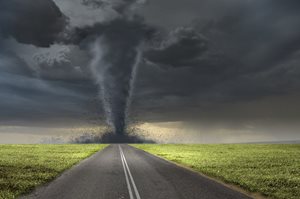(1/31/2022)
Mid-December is not when you expect to see tornado warnings. Unfortunately, this month saw a devastating tornado event across the South and Midwest that left 88 dead and 122 missing. The first priority of a healthcare facility is always the provision of care in the community. Healthcare workers and first responders take responsibility for the first step of the healing process after a disaster. However, when damages from a severe storm impact a facility's ability to provide care, the next steps taken for recovery are crucial.

The early evaluation of the outbreak's losses and economic costs illustrates exactly how catastrophic the tornadoes were for the eight states affected. According to AccuWeather Founder and CEO Dr. Joel N. Myers, the tornadoes are likely to cost roughly $18 billion in total damage and economic loss, making the outbreak
the costliest tornado event in US history.
Healthcare facilities can’t simply wait to file insurance claims in the weeks that follow a disaster – it leaves too much room for error in reporting. Facilities can lose claims opportunities, and in that instance, insurance loses its value. When disaster strikes, we must be prepared; this includes planning for the inevitable financial consequences. There are more effective approaches to prepare your healthcare facility for disaster recovery and support.
Prepare for Oncoming Disasters
In the case of a forecasted event, healthcare facilities must have a strategy in place to monitor the administrative documentation they will need to file insurance claims. Teams must be trained in the critical tasks of saving all receipts, taking "before" pictures, and properly obtaining local assistance so that when insurance claims are filed, facilities have all of the information they need to demonstrate the disaster's impact on the facility and receive the full benefit of their insurance policy.
Call Upon FEMA
The Federal Emergency Management Agency, FEMA, is a valuable resource for facilities before and after emergencies. FEMA will assist state, local, tribal and territorial governments, as well as certain private nonprofit organizations, in responding to and recovering from catastrophic disasters or crises. FEMA's Public Assistance Program can reimburse any expenditures that private, not-for-profit healthcare systems incur after a disaster that are not covered by insurance. FEMA will reimburse system costs for services such as debris removal, overtime pay for workers, procurement of special equipment such as chainsaws or generators, and repair to damaged equipment or infrastructure following disasters such as hurricanes, tornadoes, earthquakes or wildfires. Since 2019, we have collected over $3.5M in FEMA Public Assistance.
You will be more effective in collecting FEMA's full aid if your facility has all of the necessary invoices, pictures and proof of dealing with local governments, just like you would when filing insurance claims.
Prepare to Prepare: FEMA Hazard Mitigation Assistance Grants
Most facilities know what disasters they may be at risk for through their annual Hazard Vulnerability Assessment. Before disaster strikes, FEMA's Hazard Mitigation Assistance Grants can offer financing for qualifying mitigation actions to prevent disaster losses for facilities that are aware they are at risk. A facility can break the cycle of
crisis > damage > reconstruction > recurring devastation by reducing or eliminating long-term dangers to people and property that may occur during a natural disaster. This is a long-term solution that will benefit your community and strengthen your facility. FEMA will cover 75% of the costs of disaster mitigation, similar to the Public Assistance Program.
For example, two of our facilities in Florida were recently awarded Hazard Mitigation Grants totaling more than $90 million. This investment not only ensures that the facilities are available in the event of a disaster but also preserves their infrastructure, which may reduce insurance costs. You may lower the cost of your coverage by lowering risk.
There are too many hospitals that are missing out on this money. Some hospitals are unaware of the program, while others believe that going through all of the paperwork and applying is too difficult. Don’t squander this chance! Receipts, pictures and documentation from administrative preparation should already be on hand. Transferring these records to a grant application isn't much more effort than you'll already be doing to get the most out of your insurance plans.
Apply for Funding
To get started, go to FEMA's website and search for information on the
Public Assistance Program and
Hazard Mitigation Assistance Grants. FEMA collaborates with each state's emergency management agency, so you should do the same if you're pursuing funding. Continue to create and maintain your ties with local organizations to both prepare for and minimize catastrophes. Your local (county or municipal) emergency management agency may also be able to aid in procuring funds.
From all of us at Medxcel, our hearts go out to the families impacted by this devastation. As climate change exacerbates natural disasters around the country, healthcare facilities must be ready for the worst – the time for preparation is now. Hospitals are crucial in times of crisis, and any effort facilities can make to prepare for disasters, recover faster and avoid damage in the first place will help the greater community prepare for emergencies.